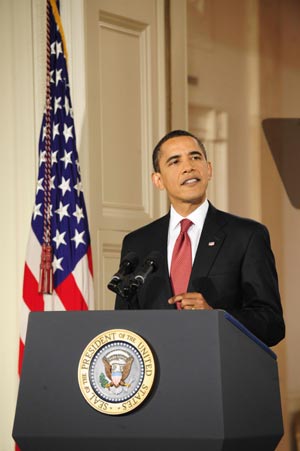U.S. President Barack Obama's administration on Tuesday unveiled its long-expected reshaped financial rescue plan.
But the plan has so far failed to shore up investors' confidence as it did not offer enough details on key questions like how toxic assets will be priced and how to get banks to start lending.

|
|
U.S. President Barack Obama speaks during his first news conference as president in the East Room of the White House in Washington Feb. 9, 2009. [Xinhua/Zhang Yan]
|
New rescue plan
U.S. Treasury Secretary Timothy Geithner introduced the Financial Stability Plan in Washington on Tuesday morning. Different from providing capital to financial institutions in the first half of the Trouble Assets Relief Program (TARP), the new plan includes measures to "help restart the flow of credit, clean up and strengthen banks, and provide critical aid for homeowners and for small businesses."
The government "will impose new, higher standards for transparency and accountability," Geithner said.
"The force of government support was not comprehensive or quick enough to withstand the deepening pressure brought on by the weakening economy," Geithner said in his speech, referring to why the Obama administration is fundamentally reshaping the program to repair the financial system.
Under the new rescue plan, a Public-Private Investment Fund will be created to provide government capital and financing to leverage private capital to buy up the "toxic assets." Banks who fail the comprehensive "stress tests" will receive more capital injections from the government.
The "stress tests" will be jointly designed by the Treasury, the Federal Reserve (Fed), the Federal Deposit Insurance Corporation and federal bank regulators to ensure the nation's largest banks can withstand a worsening economy.
In addition, up to 1 trillion U.S. dollars will be leveraged to kick-start the secondary lending markets.
"From a macroeconomic standpoint, the key point is that the banks will be healthier tomorrow than they are today as a result of these proposals," Ian Shepherdson, U.S. chief economist of High Frequency Economics, wrote in a note to clients.
Market response
Despite the introduction of the new package, U.S. stocks plunged afterwards. The Dow Jones index dove nearly 382 points, or 4.62 percent, to 7,888.88, the biggest decline since Dec. 1.
Broader stock indicators also tumbled. The Standard & Poor's 500 Stock index dropped 4.91 percent to 827.17, the biggest drop since Obama took office on Jan. 20. The Nasdaq composite index also fell 4.20 percent to 1,524.73.
Meanwhile, light sweet crude for March delivery slid by 2.01 dollars to 37.55 dollars a barrel on the New York Mercantile Exchange. The dollar strengthened against other major currencies, and gold prices also rose.
Financial shares lost ground, as Bank of America Corp. tumbled 19.3 percent to 5.56 dollars a share, Wells Fargo & Co. shares fell 14 percent to 16.35 dollars, and Citigroup plunged 15.19 percent to 3.35 dollars.
A survey by CNBC of more than 32,000 investors showed that 67 percent of them believed that the new proposal would not solve the current financial crisis.